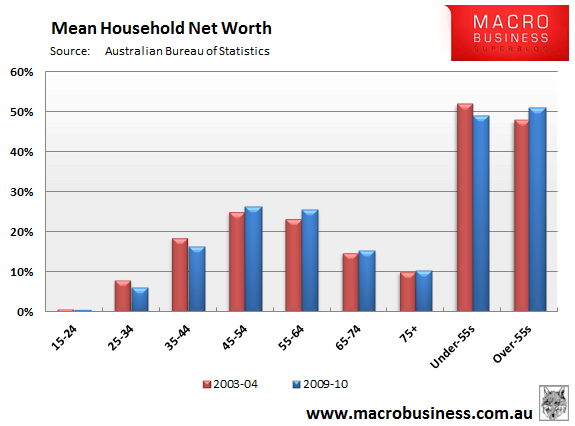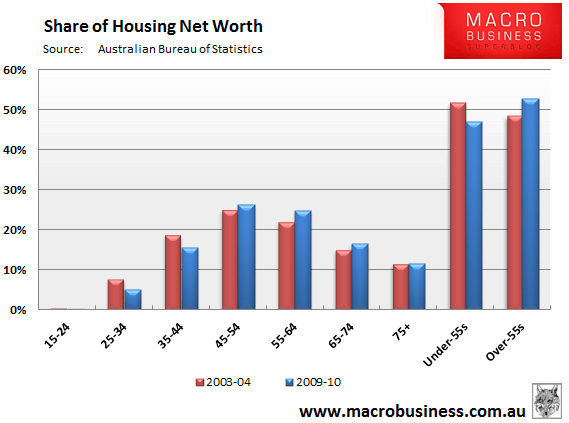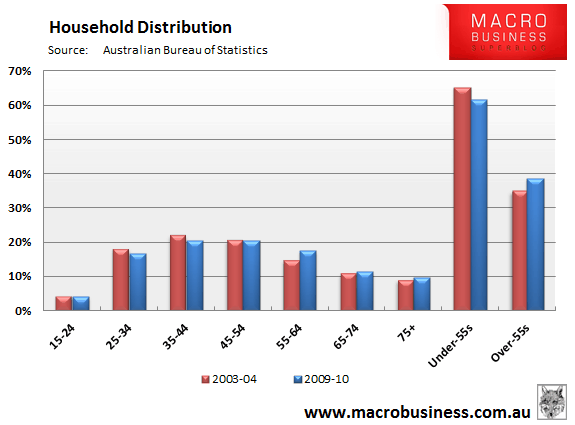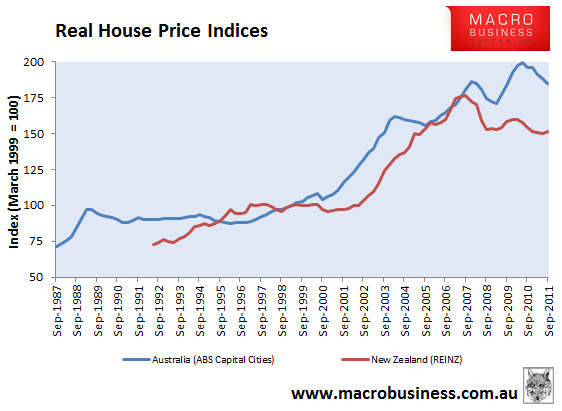
By Leith van Onselen
Over the weekend, Interest.co.nz’s Bernard Hickey posted a cracking article showing how the distribution of household wealth in New Zealand has shifted heavily towards the older generation courtesy of the housing boom:
This week Roy Morgan published its annual State of the Nation survey showing a stunning rise in the wealth of New Zealanders aged 55 and over…
The report confirms an extraordinary shift in the structure of wealth in New Zealand that raises huge questions for politicians, policy makers and voters for years to come…
The gross wealth of those aged 55 and over has risen from NZ$188 billion in 2002 or 37% of total wealth to NZ$525 billion or 47% of total wealth. This growth was only partly due to a rise in proportion of the population who are 55 and over to 24.7% from 19.5%.
That 2002 to 2011 period was dominated by the housing boom from 2002 to 2007 when house prices virtually doubled, even after accounting for inflation. Anyone owning property early in that period is now much, much richer, given many had leveraged investments in their properties because of their mortgages…
The picture becomes starker when looking at net worth… Those aged 55 and over added just NZ$21 billion in debt to NZ$32 billion over that 2002-2011 period. The bulk of the extra NZ$100 billion of debt added by New Zealand households over that period was taken on by those under 40 who had to leverage up to get into the housing market…
The unlucky ones were those that took on massive debts in the last five years to buy houses at the newly inflated prices. They were mostly below 40.
The net worth of those 55 and over rose to NZ$492 billion or 52% of the total by 2011 from NZ$176 billion or 43% of the total in 2002. The survey shows 71.4% of that wealth is tied up in their own homes.
This structural shift in wealth to the aged and a loading up of debt on the young is obviously not sustainable, particularly when combined with the current promises of universal superannuation from 65 and publicly funded healthcare. With the current policies, New Zealand faces the bizarre prospect of either higher income tax rates on the increasingly indebted young to pay for pensions and ‘free’ healthcare for the increasingly wealthy old, or huge amounts of government borrowing, which would of course have to eventually be paid repaid by the young.
No wonder a record number of mostly young New Zealanders left to live in Australia in the last year.
Australia’s wealth appears to be distributed in a similar way to New Zealand. The below charts, which have been created from The Australian Bureau of Statistics (ABS) Household Wealth and Wealth Distribution surveys, provide a snapshot of Australian wealth as at the 2003-04 and 2009-10 financial years, thus providing a sense of how the wealth distribution has changed over time.
First, the below chart shows the distribution of total household net worth (i.e. the total value of assets less debt):

According to the ABS, over-55s held 51% of the nation’s net worth in 2009-10, an increase of 3% since 2003-04. Not surprisingly, this increase in the share of wealth was on the back of housing, where net worth for the over-55s rose to 53% in 2009-10 from 48% in 2003-04:

However, virtually all of the increase in the share of net worth to the over-55s was due to that cohort growing in size relative to the rest of the population, rather than through an increase in asset values per se. In 2009-10, over-55s represented 38% of the population compared to 35% in 2003-04:

Although Australia seems to have a similar debt distribution to New Zealand, it appears from the data to have experienced a more moderate rise. One logical reason is that the Australian housing market boomed earlier than in New Zealand and the big expansion in income to price multiples had largely run its course by 2003-04 – the date of the first ABS Survey (see below chart). As a result, the over-55s share of net worth was already elevated in 2003-04 on the back of higher housing values:

With Australia’s population ageing, over half of the nation’s wealth held by those aged over-55, and a diminishing pool of younger buyers available to purchase those assets (along with the prospect of steadily rising tax burdens to pay for the ageing population), asset price growth is likely to be much harder to achieve in the future, all other things being equal.

